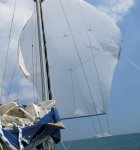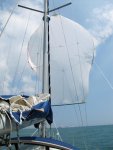flaming
Well-known member
Just too much sail for me - spinnakers look always to be on the edge of control! Plus have a cruising chute and happy enough gybing downwind. Got a healthy reserve though so if it doesn't meet that then maybe one day I'll have a play.
The penny has just dropped that you must have inherited it when you bought the boat, rather than ordering one but selling it before even trying it. I think I need an afternoon coffee....


